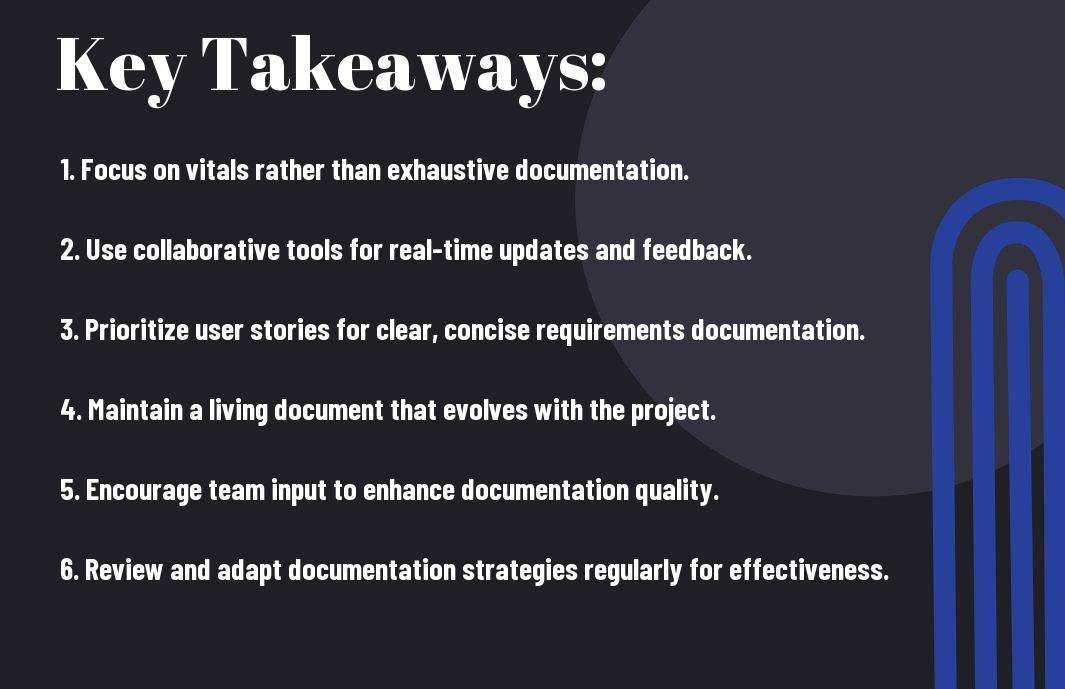It’s necessary to understand that effective project documentation in Agile project management can greatly enhance team collaboration and project success. In my experience, adopting the right strategies can transform how you capture and share information. By focusing on flexibility and clarity, you can ensure that your documentation evolves alongside your project. In this post, I will share valuable insights and practical approaches that will not only streamline your documentation process but also empower your team to stay aligned and responsive to change.
Key Takeaways:
- Clarity: Ensure that all project documentation is straightforward and understandable to all team members to facilitate effective communication.
- Adaptability: Be flexible in documenting processes; Agile projects may require updating or altering documentation as the project evolves.
- Collaboration: Foster teamwork by involving the whole team in the documentation process, promoting a shared understanding of project goals.
- Minimalism: Keep documentation concise and focused on what’s necessary to reduce overhead and increase efficiency.
- Continuous Improvement: Regularly review and reflect on documentation practices to enhance their effectiveness in supporting Agile methodologies.
Understanding Agile Project Management
Your journey into Agile Project Management begins with an appreciation for its core philosophy, which emphasizes flexibility, collaboration, and rapid delivery. Unlike traditional project management methods that follow a linear path, Agile encourages iterative progress through short cycles, allowing teams to adapt to changes and pivot as needed. This dynamic approach fosters a more responsive environment that prioritizes customer satisfaction and continuous improvement.
Key Principles of Agile
Across Agile frameworks, certain key principles stand out, including customer collaboration, welcoming changes, and maintaining a focus on delivering working products incrementally. These principles are designed to enhance your project’s adaptability, allowing you to respond effectively to feedback and evolving requirements, ensuring your project remains aligned with user needs.
Agile Methodologies Overview
One of the defining features of Agile is its array of methodologies, each offering unique practices and frameworks to guide teams in managing projects effectively. From Scrum to Kanban, these methodologies provide structured yet flexible approaches that can be tailored to your specific project context.
Considering the diversity of Agile methodologies, you’ll find each one has its own strengths and challenges. For example, Scrum is popular for its time-boxed sprints and defined roles that enhance accountability and focus. In contrast, Kanban provides a visual workflow management system that allows for continuous delivery, which can drastically reduce lead times. As you explore these options, keep in mind that while adopting a specific methodology, it’s vital to maintain the underlying Agile principles that empower your team to work effectively and adaptively.
Importance of Documentation in Agile
There’s a fundamental belief in Agile that keeps the focus on delivering value quickly. However, this doesn’t diminish the importance of documentation. Effective documentation serves as a tool for clear communication, ensuring that the team is aligned and aware of project goals, requirements, and feedback. It provides a roadmap throughout the development process and supports continuous improvement. By documenting decisions, we empower future iterations and help onboard new team members seamlessly.
Balancing Documentation and Agility
Balancing documentation and agility involves knowing what to document without stifling the team’s flexibility. While Agile promotes adaptive planning and encourages face-to-face communication, imperative documentation still plays a vital role. It is about creating lightweight, effective documents that can support progress without becoming a burden. This balance helps preserve the team’s ability to pivot while maintaining a clear understanding of objectives and changes.
Types of Essential Documentation
By identifying types of imperative documentation, you ensure that you capture necessary information without overloading your process. Important documents include:
| User Stories | Define features from an end-user perspective. |
| Acceptance Criteria | Outline how features are validated by stakeholders. |
| Meeting Notes | Record discussions and decisions made during meetings. |
| Project Backlog | Keep track of tasks and their statuses. |
| Retrospective Notes | Highlight lessons learned and areas for improvement. |
Assume that by maintaining these documentation types, you’ll keep your team more organized and focused.
And diversifying your documentation approach ensures that you cover all necessary angles. Each type serves a specific purpose, enriching your Agile process. Here is a breakdown of imperative documents again:
| Product Roadmap | Visual representation of goals and deliverables. |
| Technical Specifications | Detail requirements for technical components. |
| Design Documents | Outline UI/UX decisions and guidelines. |
| Release Notes | Summarize new features and updates. |
| Compliance Documentation | Ensure adherence to industry regulations. |
Assume that by keeping a balance, you’ll foster an environment of transparency and help your team navigate challenges effectively. Your documentation can set the foundation for a more collaborative and productive Agile process.
Project Initiation Documentation
Many project managers recognize that effective documentation during the initiation phase is a cornerstone of successful Agile project management. This phase sets the tone for the entire project by defining objectives, scope, and stakeholder engagement strategies. When thorough documentation is created, it helps align team members, ensures clarity, and lays a solid foundation for an adaptable process moving forward.
Defining Project Goals and Scope
Project goals and scope provide a roadmap that guides the project team throughout the lifecycle. By establishing clear objectives, I can ensure that everyone understands the expected outcomes and avoids any misalignment as we progress. Defining the scope allows me to identify the boundaries of the project, outlining what is included and what is not, which is crucial for maintaining focus and avoiding scope creep.
Stakeholder Identification and Engagement
Project management thrives on stakeholder engagement, and identifying key stakeholders early lays the groundwork for successful collaboration. A careful analysis allows me to ascertain who holds a vested interest in the project and how they can impact its success. Ensuring that diverse perspectives are understood and incorporated into the decision-making process fosters dedication and decreases resistance down the line.
Scope definition is not just about outlining what will be done; it also means actively seeking input from stakeholders. When I engage them effectively, it not only enriches the project with different viewpoints but also fosters a sense of ownership among participants. It’s important to actively solicit their input to identify their needs and expectations. Doing so can significantly influence project success since these relationships can become either assets or obstacles if not managed well. Effective communication helps mitigate risks, especially when negative feedback emerges. Thus, embracing stakeholder engagement sets a positive tone for the journey ahead.
Planning and Continuous Documentation
To ensure effective agile project management, I advocate for a robust approach to planning and documentation that evolves throughout the project lifecycle. This involves not only meticulous upfront planning but also embracing continuous documentation practices. By integrating documentation into our daily activities and making it an integral part of sprints, I can maintain clarity for the entire team, streamline communication, and adapt quickly to changes. The goal is to facilitate collaboration and enhance the understanding of project goals among all stakeholders.
Sprint Planning and Backlog Management
After establishing the project vision, I prioritize sprint planning and backlog management to define actionable tasks. During sprint planning sessions, I work closely with my team to break down the project backlog into manageable user stories, ensuring that each member understands their responsibilities. By doing so, I set a clear roadmap for the sprint, allowing the team to focus on delivering value incrementally while ensuring that documentation is a byproduct of our work.
Daily Stand-ups and Progress Tracking
With daily stand-ups, I facilitate communication and provide a space for team members to discuss progress, roadblocks, and plans for the day. This open dialogue fosters a team-centric atmosphere where we can quickly identify and resolve issues, leading to enhanced project flow. I encourage everyone to share updates briefly to keep the meeting concise and focused.
Sprint stand-ups help to create a culture of accountability within the team. They ensure that I stay informed on each team member’s progress, promoting proactive problem-solving. I find that these meetings shine a light on any potential challenges, allowing us to address them before they escalate. They serve as a motivational checkpoint, reinforcing our goals and objectives, and I encourage active participation to cultivate a sense of ownership among team members, fostering a positive and productive environment.
Collaboration Tools and Techniques
Once again, fostering a collaborative environment is crucial in Agile project management. By utilizing appropriate collaboration tools and techniques, teams can communicate fluidly and maintain alignment throughout the project lifecycle. From virtual brainstorming sessions to real-time feedback platforms, effective collaboration not only enhances productivity but also encourages innovation and flexibility within your team.
Leveraging Digital Tools for Documentation
Documentation plays a vital role in ensuring that all team members are on the same page and that critical information is easily accessible. By leveraging digital tools such as cloud storage, wikis, and project management software, you can ensure that your documentation is up-to-date and easily shareable. This reduces the risk of miscommunication and allows your team to adjust swiftly to changes or new insights.
Best Practices for Team Collaboration
Tools that facilitate team collaboration can significantly enhance project outcomes. Effective communication platforms, shared document editors, and visual project boards help you streamline ideas and tasks. In addition, establishing clear roles, setting expectations, and maintaining an open dialogue are best practices that contribute to a harmonious working environment. This way, each team member feels valued and empowered to contribute, leading to enriched collaboration and increased productivity.

Review and Retrospective Documentation
All aspects of project management demand reflection, and the review and retrospective phases are no different. These sessions provide invaluable opportunities to gather insights on what worked well and what didn’t, allowing you to adjust your processes accordingly. By documenting these reflections, you create a historical reference that can significantly enhance your team’s performance in future sprints.
Documenting Lessons Learned
An effective way to enhance your agile practice is through careful documentation of lessons learned during retrospectives. It’s important to capture both successes and failures, enabling you and your team to analyze patterns and make informed decisions going forward. Recording these insights fosters a culture of continuous improvement, contributing to better project outcomes.
Updating Documentation for Future Sprints
Across the various phases of your agile project, it is vital to keep your documentation up-to-date with the latest insights gained from retrospectives. As you move into future sprints, ensure that you revise any existing documentation, addressing the lessons learned and the changes implemented based on them. This practice not only helps maintain clarity but also ensures that the team does not repeat past mistakes.
Indeed, keeping documentation updated is the backbone of an efficient agile process. With each sprint, I prioritize revising project documents to reflect newly agreed-upon strategies, acknowledge challenges previously faced, and outline the potential solutions. This not only reinforces a shared understanding amongst team members but also empowers you to track progress over time. Additionally, being proactive in updating your documentation can help mitigate risks associated with historical issues, saving your team from potential setbacks. Ultimately, the iterative nature of agile project management relies on reflective practices like these, leading to a more robust, agile environment.

Summing up
Presently, I emphasize the importance of effective project documentation strategies in Agile Project Management. By focusing on concise and relevant documentation, you can enhance collaboration and improve overall team efficiency. It’s vital to adapt your documentation style to suit the needs of your project while ensuring that all relevant information is easily accessible. I encourage you to explore more about Agile methodologies through resources like Agile Project Management: Best Practices and … to optimize your strategies further.
FAQ
Q: What are the key components of project documentation in Agile project management?
A: Key components of project documentation in Agile include user stories, product backlog, sprint plans, meeting notes, and retrospectives. User stories describe features from the user’s perspective, the product backlog is a prioritized list of work items, sprint plans outline the work to be completed in a given sprint, meeting notes capture discussions and decisions, and retrospectives document lessons learned after each iteration.
Q: How often should documentation be updated in Agile projects?
A: Documentation should be updated continuously throughout the project lifecycle. Agile emphasizes iterative development, so as requirements and understanding evolve, documentation must also reflect these changes. Key moments for updates include sprint planning, daily stand-ups, and retrospectives.
Q: What tools can facilitate project documentation in Agile environments?
A: Various tools can enhance project documentation in Agile settings, such as Confluence, Jira, Trello, and Asana. These platforms allow teams to effectively manage tasks, maintain backlogs, create wikis for knowledge sharing, and track progress, making documentation accessible and up to date for all team members.
Q: How does Agile documentation differ from traditional project management documentation?
A: Agile documentation is typically more lightweight and adaptive compared to traditional approaches. Instead of extensive upfront documentation, Agile focuses on creating just enough documentation to support communication and collaboration among team members. It prioritizes flexibility and quick adjustments, allowing teams to respond to change rather than adhering strictly to predefined plans.
Q: What are some best practices for effective documentation in Agile projects?
A: Best practices for effective documentation in Agile include keeping documents concise, focusing on necessary information, using collaborative tools for real-time updates, involving the whole team in documentation processes, and regularly reviewing and refining documents to ensure relevance. Additionally, using visual aids like diagrams and flowcharts can enhance understanding and retention of information.







